Cleaning the well itself
A well, like any other structure, may eventually fail, this will affect the amount of water it will produce. If the cause is not eliminated in time and preventive measures are not taken, the problem will be aggravated, which will eventually lead to a complete loss of the well. In this case, you need to clean the well with your own hands or with the help of specialists.
The reasons for the decrease in well production
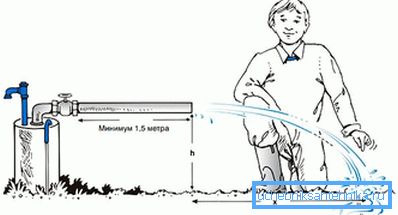
The reason for the fall of the static and dynamic water level in the well, and as a result, a decrease in flow rate may occur for several reasons:
- Depletion of the aquifer.
- Defects made by the drilling organization in drilling and well equipment.
- Due to siltation of the wellbore by geological formations.
- Calculating the filter and the filter zone by chemical and geological deposits.
- Due to occasional use or long well shutdown.
The most common reason for reducing the flow rate, which is found in household wells on water, is its siltation. This happens, as a rule, due to malfunction of the filter glands, lack of bottom in the sump, corrosion of the mesh filter or casing, improper gravel dusting.
Cleaning methods
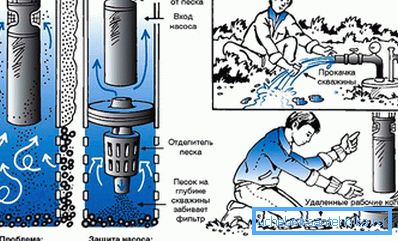
Before proceeding with the cleaning, you need to familiarize yourself with the information about the well design and determine the cause of its failure, in order to choose the right cleaning method. There are many ways to clean and restore a well, depending on what caused the decrease in flow rate:
- mechanical cleaning of the inner surface of the filter with metal ruffs and scrapers;
- removal of sand plugs and sludge using a pump or zhelonka;
- chemical method of cleaning mineral deposits on the filter by pumping acids into the well;
- cleaning with zhelonka;
- explosion method and water hammer.
Mechanical scum cleaning
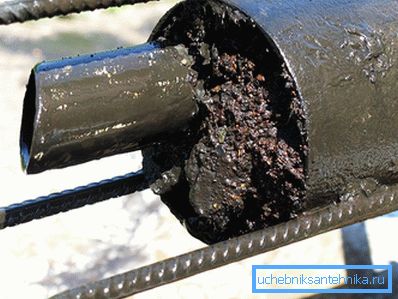
The most effective method for extracting a sand plug from a well is zoning. It is used in the case when the sand plug completely blocked the filter. The shell is a metal pipe, in the lower part of which there is a valve. The diameter of the stalk depends on the diameter of the filter string of the well. The difference between the diameters must be at least 50 mm with a well depth up to 200 m.
The principle of cleaning a well with the help of a choke is to sharply raise and lower the choke to the bottom of the well.
When falling, water with swollen sand enters the shell, the flow of which is prevented by the valve, as soon as the pipe is half full, it is removed to the top and water is poured. Zoning is rational to combine with water washing in the case of a low dynamic level or when removing tight plugs after they are washed out. Although this method is laborious and time consuming, it shows an excellent result.
Removing sand plug with vibrating pump
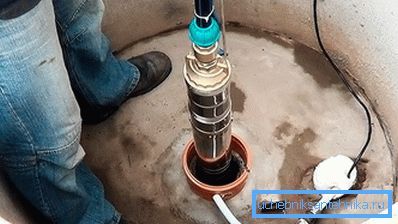
If the cause of failure of the well was the silting or the sand plug, you can clean it with a vibration pump. For these purposes, the vibrating pump must have water inlets at the bottom. Before you clean the well in the country, the pump needs a little refinement. To do this, screw the extreme nut on the tip of the pump, in the place where the suction inlets are located, and place a metal bracket 15 cm in length at the center. This design allows the mud to be shaken better at the bottom of the well. To the pump, in addition to the cable and hose, you need to tie a strong cord for which it will rise and fall. It should be lowered to the full depth, before contact with the sand plug. Water must be present in the well, otherwise it will need to be poured from above.
After all the preparatory work, turn on the pump and begin to carry out a slight rocking motion up and down, the pump should always be at the bottom of the well. When rocking, the screwed arm stirs up the mud, and the pump pumps the water with the contaminants upward. Periodically, you need to pull out the pump and inspect the inlets. If they are clogged, they need to be cleaned; you must also make sure that the pump does not overheat.
Cleaning this way may take some time, it all depends on how heavily silted well. With good skill, the well really cleaned for 1 day.
Water jet

This method is used when there is a small column of water above the sand plug and the plug is cemented. For this method, you will need a pump installation that can create a head from 6 to 12 atm. The depth of the descent and the diameter of the wash pipe depends on the depth of the plug and the diameter of the filter column.
With a casing diameter of 168 mm, the difference between the wash and the casing is 75 mm. A 50 mm with a diameter of casing less than 168 mm.
For cleaning applies direct and backwash. Before the start of washing, the well is filled with water, the washing hose with the nozzle is lowered before the start of the plug, and a large head is supplied. The nozzle size is recommended with a length of 200 mm with an initial diameter of 35 mm and a final diameter of 10 mm. Under the action of hydrostatic pressure is the resolution and leaching of sediment to the outside. The difficulty of this method is the problem of providing water for washing. As a power plant, you can use the services of a fire truck.
Whatever cleaning method you choose, after cleaning, the well must be pumped until the water is clear. Pumping can be done in several stages.
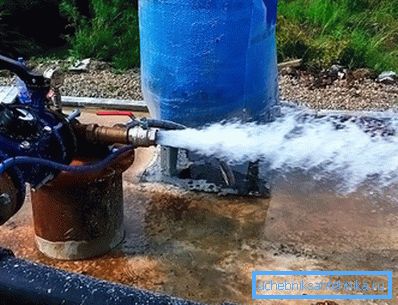
Not all methods of well cleaning can be performed independently, some of them require special adaptations and skills, therefore in particularly difficult cases you cannot do without the involvement of specialized brigades.
Maybe you will be interested in familiarizing yourself with such topics:
How to insulate the well for the winter with their own hands
The head for the well do it yourself
Well cementing
How to get the pump from the well
Video
Learn more about how to clean the well, you can find out by watching the video: